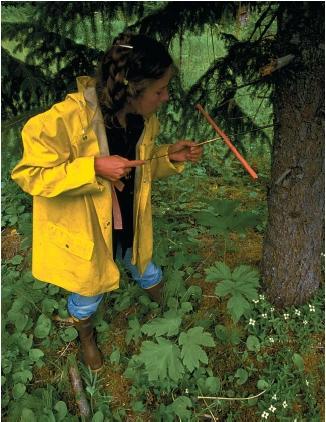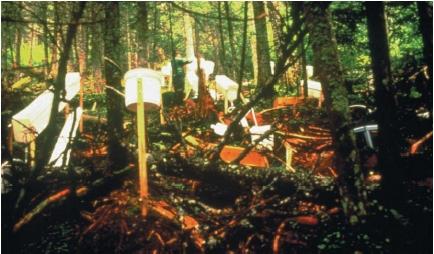Forestry
Forestry is usually defined as the science of the harvesting, planting, and tending of trees, primarily in managed forested landscapes. In the first 250 years after Europeans came to North America, little or no effort was made to protect the continent's forest resources. Most people thought they could harvest trees without limit almost anywhere. The vastness of the North American continent gave the impression that an unlimited supply of timber was available.
By the late nineteenth century, however, some individuals saw the foolishness of this philosophy. Vast forest areas in the eastern and midwestern United States had been totally cleared of trees. Similar efforts to cut down and use trees as rapidly as possible were occurring at the nation's last frontier, the Far West. At this point, a movement was initiated to think more carefully about the nation's forest resources. People began to develop plans either to preserve or conserve those resources. Preservation meant protecting forests entirely from human use, while conservation meant using forest resources wisely to ensure that they would be available for future generations. Out of this movement grew the modern science of forestry in the United States.
Words to Know
Clear-cutting: A forest harvesting system that involves the cutting of all trees of economic value in a given area at the same time.
Conservation: The act of using natural resources in a way that ensures that they will be available to future generations.
Forest harvesting: Methods used to cut and remove trees from the forest.
Game animal: An animal that is hunted for food or recreational purposes.
Herbicide: Any chemical that kills plants.
Natural regeneration: A method of growth in which foresters rely largely on natural processes for trees to regrow in an area.
Prescribed burn: The controlled burning of vegetation in an area to achieve some effect.
Preservation: The act of protecting a natural resource from any human use.
Regeneration: The process by which the trees in a forest ecosystem are restored over time.
Selection-tree system: A forest management system in which some of the larger individual trees of a desired species in an area are harvested every ten or more years.
Shelter-wood cutting: A forest management technique in which certain large trees are left behind in an area that is otherwise cut.
Silviculture: The branch of forestry that is concerned with the cultivation of trees.
Strip-cutting: A forest management system in which long and narrow clear-cuts are made, with alternating uncut strips of forest left between.
Forestry and agriculture
In many respects, forestry is similar to agricultural science, and foresters are comparable to farmers. Forestry and agriculture both deal with the harvesting and management of ecological systems. Both fields also look for ways to make the best possible use of land to produce valuable products. However, some important differences between the two fields exist. In the first place, agriculture deals with a greater variety of species and products, while forestry deals essentially with one species: trees. In addition, farmers deal with a wider range of harvesting and management systems, most of which are much more intensive than in forestry. Finally, agriculture involves relatively short harvesting rotations, with most crops being planted and harvested once a year. Still, the goals of forestry and agriculture are very much alike: harvesting and managing crops to produce ongoing yields of organic products that are required by society.
Another shared feature of forestry and agriculture is that both substantially deteriorate the original ecosystems of the area. For example, populations of many native species of plants and animals may be reduced, threatened, or even eliminated. The soil is often eroded, the environment may become contaminated with pesticides and fertilizers, and the beauty of the landscape may be degraded. One of the most important challenges to both forestry and agriculture is to achieve their primary goals of maintaining harvests while keeping the environmental damage within acceptable limits.
Goals of forest management
Forests are important for a number of reasons. They are used to provide a vast array of products that include lumber, plywood, pulp and paper, and other wood products. Many fish (particularly salmon) and furbearing animal species (marten, fisher, and beaver) that live in forested lands are valuable commodities. Forests are home to species of game animals such as deer, rabbits, and quails that are hunted for food and for recreational purposes. But the great majority of the species of forested landscapes are nongame animals which, though not economically important, are nonetheless valuable.
Forests also provide people with recreation: bird watching and other wildlife observation, hiking, and cross-country skiing. And many people enjoy forests simply for their great beauty. Forests also play a vital role in the ecology of the planet. In addition to preventing erosion and helping to maintain the water cycle, these stands of trees provide atmospheric oxygen.
Highly publicized, intense debates rage as to the best possible uses of forest resources. For instance, in North America there are concerns about the negative effects of forestry on endangered species, such as the spotted owl and red-cockaded woodpecker, and on endangered ecosystems, such as old-growth forests. In a few cases, these concerns have been addressed by declaring large tracts of natural forests to be off limits to commercial harvesting of timber. In general, however, logging industry interests are seen as having a higher value to society.
Harvesting and management
There are a number of methods used to cut and remove trees from the forests. Forest harvesting methods vary greatly in their intensity. Clear-cutting is the most intensive system, involving the harvest of all trees of economic value at the same time. The areas of clear-cuts can vary greatly, from cuts smaller than a hectare in size to enormous harvests thousands of hectares in area.
Strip-cutting is a system in which long and narrow clear-cuts are made, with alternating uncut strips of forest left between. One advantage of strip-cutting is seeds from uncut trees fall into the harvested strips, and new trees soon begin to grow there.
Shelter-wood cutting is a technique in which certain large trees are left behind in an area that is otherwise cut. The large trees produce seeds from which the next generation of trees will be born. In addition, the large trees will be even larger at the time of the next cutting in the area.
The least intensive method of harvesting is the selection-tree system. In this system, some of the larger individual trees of a desired species are harvested every ten or more years. The forest overall, however, is always left essentially intact.
Regeneration. Forest management involves decisions not only as to how trees are to be harvested, but how the forest is to be regenerated. Ideally, one might hope that a new tree grows in an area for every older tree that was taken out. One method for dealing with this problem is natural regeneration. Natural regeneration refers to the practice of simply allowing a forested area to grow back on its own, once trees have been harvested. Natural regeneration can be aided by humans in a number of ways, such as leaving younger trees in place while only larger trees are harvested and preparing the ground to increase the rate of germination for tree seeds.
Natural regeneration is an ecologically responsible way to promote the regrowth of a forest area. But the process often takes a great deal of time and, therefore, may not be economically desirable.
More managed forms of regeneration are also possible. For example, young seedlings of valuable tree species may be planted and grown in greenhouses before being transplanted to the forest. This technique assures that high-quality trees of just the right species will grow in a particular area.
Once an acceptable population of trees has been planted in an area, intensive tending may be needed to protect these trees from forest fires, attack by pests, and intrusion of undesirable species. This form of management is very time-consuming, and is more likely used on tree farms.
One of the more widely used methods of forest management is known as a prescribed burn. A prescribed burn is the controlled burning of vegetation to achieve some effect. Most commonly, fires are intentionally set to reduce the amount of logging debris present after clear-cutting.

This practice is generally undertaken to make the site more accessible to tree planters.
Sometimes prescribed burns are also useful in developing better seedbeds for planting tree seedlings. Prescribed burns also can be used to encourage natural regeneration by particular types of trees that are economically valuable, such as certain species of pines. When using fire for this purposes, it is important to plan for the survival of an adequate number of mature seed trees. If this is not accomplished, the burned site would have to be planted with seedlings grown in a greenhouse.
Silviculture
Silviculture is a special field of forest management that involves the development of activities designed to establish, tend, protect, and harvest crops of trees, especially for use as timber. The term silviculture was invented to compare its activities with those of agriculture. Whereas agriculture deals with a great variety of different crops, silviculture ( silvi means "trees") deals with trees only.
As with forestry systems in general, silviculture can use techniques ranging from entirely natural to highly intensive. An example of an intensive system used in North America might involve the following series

of activities: (1) whole-tree clear-cut harvesting of the natural forest, followed by (2) breaking up of the surface of the site to prepare it for planting, then (3) an evenly spaced planting of young seedlings of a very specific type of a single species (usually a conifer), with (4) one or more applications of herbicides to free seedlings from the harmful effects of competition with weeds, and (5) one or more thinnings of the maturing plantation, to optimize spacing and growth rates of the residual trees. Finally, the stand is (6) harvested by another whole-tree clear-cut, followed by (7) establishment, tending, and harvesting of the next stand using the same silvicultural system.
In contrast, a more natural silvicultural system might involve periodic selection and harvesting of a mixed-species forest, perhaps every decade or two, and with reliance on natural regeneration to ensure renewal of the economic resource.
Because silvicultural systems can differ so much in their intensity, they also vary in their environmental impacts. As is the case with agriculture, the use of intensive systems generally results in substantially larger yields of the desired economic commodity, in this case, trees. However, intensive systems have much greater environmental impacts associated with their activities.
[ See also Forests ]
if you have any information like above please send me .
thank a lot
your faitful
mehrdad nikouye